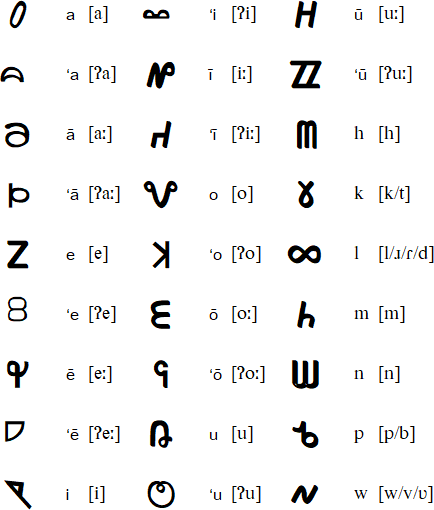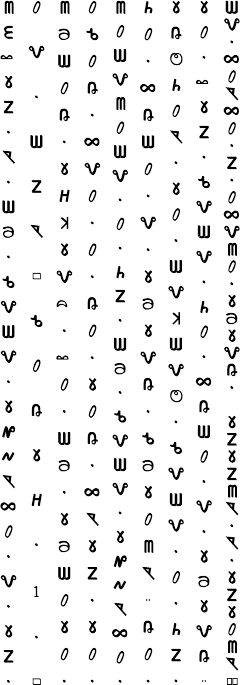Kākauna is a script constructed in 2018 by Hayyim Obadyah. It is a hypothetical script for Hawaiian, which is currently written with Latin letters. “Kākauna” is derived from the Hawaiian word for “write” (kākau) with a nominalizing suffix. In English text, it may appear without the kahakō (macron) over the first “a”.
The Hawaiian language was never written before the arrival of American missionaries in the early 1800's. They created an alphabet in order to produce a Hawaiian translation of the Bible. Hawaiians were so responsive to the concept of writing that they soon had the highest literacy rate in the world. Over 80 newspapers were regularly published in Hawaiian to meet the demand for information about the outside world.
Western diseases, however, reduced the native Hawaiian population from 300,000 in the 1770s to 60,000+ in the 1850s, and then to 24,000 in 1920. After the overthrow of Hawaii's constitutional monarchy in 1893, followed by the American annexation in 1898, the American occupation tried to suppress the language. It was forbidden in public schools and, of course, all government business was conducted only in English, rather than both Hawaiian and English as in the monarchy. At one point in the 20th century it is believed that the language had no more than 500 native speakers.
In the 1980s, though, a strong movement developed to advocate for the language's revitalization, the flagship of which was a string of Hawaiian - language pre-schools. As of 2011, the number of native speakers had increased to 2,000 and a total of 24,000 said that they are fluent in the language (although some think that the latter number is exaggerated). Native speakers continue to increase as those who learned it as a second language choose to raise their children with Hawaiian as the language of the home.
Hawaiian, together with Marquesan, is in the Marquesic group of Central Eastern Polynesian (which also includes Tahitic languages), within the Nuclear Polynesian branch of the Polynesian family. Polynesian is a family of the Oceanic group of the Austronesian languages. (Although Maori on New Zealand is Polynesian, the Austronesian languages have nothing in common with Australian Aboriginal languages.) Hawaiian is an analytic language, with no conjunctions or declensions, but frequent use of particles.
Sentences normally have Verb-Subject-Object order, but fronting is often used for emphasis. Pronouns have number (singular, dual, plural) and are inclusive or exclusive. Possessives all fall into one of two categories (“a-class” and “o-class”) which may or may not reflect an alienable - inalienable distinction.
Only (C)V syllables are permitted; i.e., no consonant can follow another and any consonant must be followed by a vowel. There are 18 phonemes, 10 vowels (short a, e, i, o, u and long ā, ē, ī, ō, ū) and 8 consonants (h, k, l, m, n, p, w, and glottal stop). The macron indicating long vowels is called kahakō. The glottal stop is called ʻokina, and is encoded as U+02BB “modifier letter turned comma”.
The original orthography developed by the missionaries did not make use of either kahakō or ʻokina. This created ambiguity, although fluent speakers could usually determine whether “pau” indicated pau (finished), pa‘u: soot, pa‘ū (damp), or pā‘ū (skirt). In translating names and Biblical terms, the missionaries also used letters such as b, f, r, etc. that do not reflect Hawaiian phonemes. Hawaiians call these “Bible letters”. They are of course not rendered at all in Kākauna.
In the mid-twentieth century, greater engagement by professional linguists in teaching Hawaiian led to greater emphasis on consistent use of kahakō and ʻokina, which is now considered standard modern Hawaiian orthography.
Kākauna was developed from the hypothetical of a native Hawaiian orthography existing prior to contact with the West. The creator decided on an alphabet as most appropriate given the syllable structure and phoneme pool. The script reflects an unrelated situation in one of the Semitic languages: although Semitic languages often do not have letters for vowels and do have a letter for glottal stop, Ugaritic, though it does not generally indicate vowels, has three letters to indicate glottal stop because they specify the following vowel: ʻa, ʻi, and ʻu.
Kākauna suggests that ancient Hawaiians might have interpreted glottal stop not as a consonant but as a characteristic of vowels. Thus, the 10 vowel phonemes would be represented by 20 symbols, each of which symbols would indicate either a vowel preceded by glottal stop or a vowel without glottal stop. Hawaiian words were identified beginning with each of the 10 vowel phonemes, the 10 glottal - stop+vowel phoneme pairs, and the 7 consonants (excluding glottal stop), for a total of 27 words. These words were then used as the basis for drawing 27 representations which were then reduced to 27 symbols.

Download an alphabet chart for Kākauna (Excel)

Hānau kū'oko'a 'ia nā kānaka apau loa, a ua kau like ka hanohano a me nā pono kīvila ma luna o kākou pākahi. Ua ku'u mai ka no'ono'o pono a me ka 'ike pono ma luna o kākou, no laila, e aloha kākou kekahi i kekahi.
All human beings are born free and equal in dignity and rights. They
are endowed with reason and conscience and should act towards one another
in a spirit of brotherhood.
(Article 1 of the Universal Declaration of Human Rights)
More details of Kākauna and the Hawaiian language (PDF)
Other constructed scripts for natural languages
Information about Hawaiian | Phrases | Numbers | Family words | Tower of Babel |
Constructed scripts for: Ainu | Arabic | Chinese languages | Dutch | English | Hawaiian | Hungarian | Japanese | Korean | Lingala | Malay & Indonesian | Persian | Tagalog / Filipino | Russian | Sanskrit | Spanish | Taino | Turkish | Vietnamese | Welsh | Other natural languages | Colour-based scripts | Tactile scripts | Phonetic/universal scripts | Constructed scripts for constructed languages | Adaptations of existing alphabets | Fictional alphabets | Magical alphabets | A-Z index | How to submit a constructed script
[top]
You can support this site by Buying Me A Coffee, and if you like what you see on this page, you can use the buttons below to share it with people you know.

If you like this site and find it useful, you can support it by making a donation via PayPal or Patreon, or by contributing in other ways. Omniglot is how I make my living.
Note: all links on this site to Amazon.com, Amazon.co.uk
and Amazon.fr
are affiliate links. This means I earn a commission if you click on any of them and buy something. So by clicking on these links you can help to support this site.
[top]